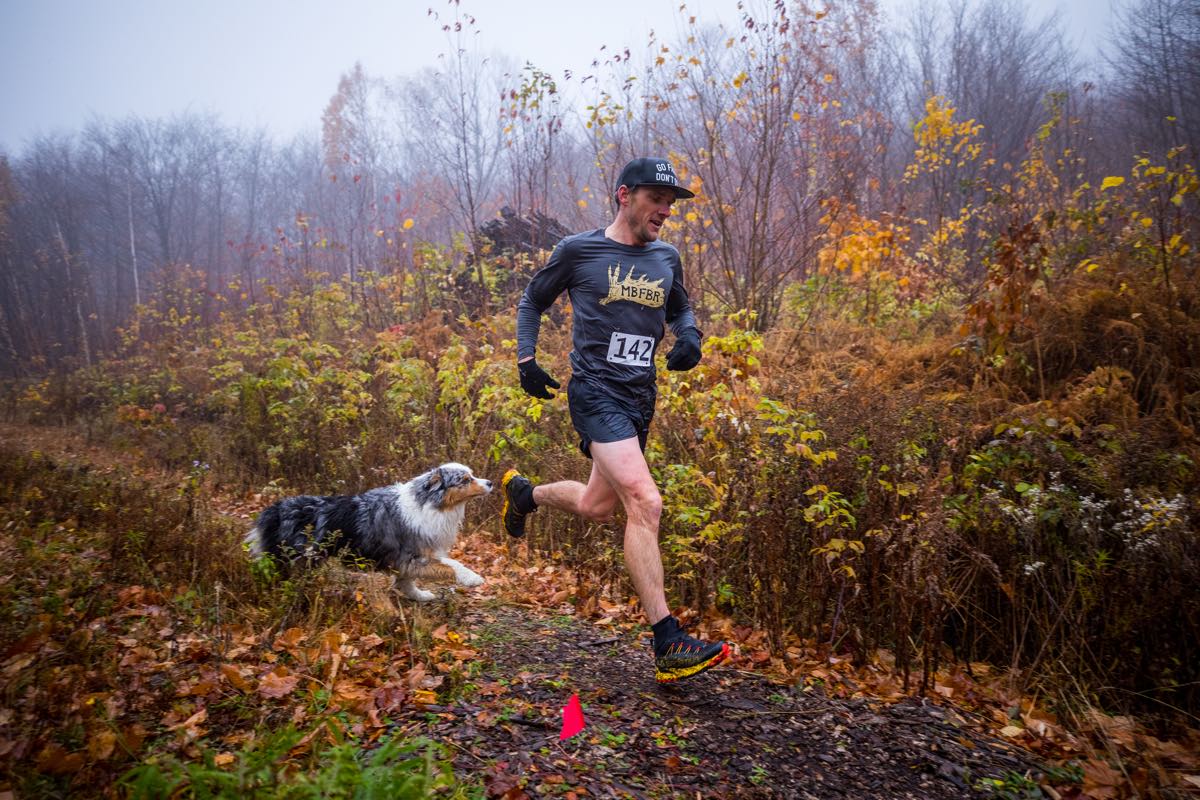A few facts: October 27th, 2019’s Randolph Ramble, a 10-kilometer mountain circuit in Randolph, New Hampshire. Seventy-seven people signed up; four ran the day before; 60 were there for the race; 58 finished.
There seemed no point in standing beneath the 12-foot square canopy of the open tent at the starting line. The wind-gusted, 39-degree-Fahrenheit rain would soak us in minutes, and the day’s only other certainty was that I would take many minutes to ‘run’ this 10k mountain loop up and then down its 2,000 feet. So as the seconds until start ticked away, I shuffled in place and watched the south wind tear remaining leaves from the trees. It was, I reminded myself, austerely beautiful, a patchwork of muted yellows, browns, and grays seen through a veil of hurried mist. It was also a window into my favorite month, fawn-colored November.
And, unlike my last race day here three years ago, it wasn’t snowing.
And there was good cheer to go around, the sort that burbles at the outset of any run or race, a mix of fellowship and anxiety. Even the dour, gray-fringed man to my right smiled a degree or two. Another solitary getting a bit of social.
Then the horn bleated, and our 120-footed pack scuffed its first steps forward. Quickly, that pack became a stretched line as the lead runners accelerated up the mild grade of the wide track. At the back, where it had seemed wise to begin, I trotted in everyone’s wake over the quarter-mile before we turned up a singletrack into the woods. Back in the mountains again, I was broadly happy; maybe I was even smiling.
I set to work. Uphill trails are 10-foot puzzles that you solve, then solve again… and again… and on. The better solutions are not linear; instead they ask side-steps and foot placements that make good use of leverage. They ask too that you not overextend and make heavy use of your muscles lifting your whole bodyweight straight up the fall line. So good climbing is a sort of dance from puzzle to puzzle. On and on. Up and up. Two-step to through-step.
Even as the final trailer in this line of ascent, I worked to restrain myself, to warm into the day without the rasp of over-breathing. A half-mile in I looked up to see the receding back of the runner ahead. Back to the puzzle. A few minutes later along an open stretch, I looked up again—woods, trail, absence. From there on, my companions would be the foot-mashed leaves and the thick scatter of glacial stones.
That leaves out the much-appreciated, stoic, stationary volunteers manning the few tricky turns and the single bailout trail. “Good job,” each said when my blue hat bobbed by, also delivering its message: last guy; good stuff; time for us to go down and get out of this rain that wants to be ice.
The day’s central climb ended around a mile and a half up, and there I tipped into wonder running the trail’s Crescent Ridge. Part of that wonder was that I was now actually running. But much of it lay in the light and duff-softened footing. Rain and mist and fog make light democratic; it spreads evenly over the ground, eschews the bright, lets even the subtle colors glow. Such light makes the near world visible, then intense. That is all there is; it rises, exalted, to meet you.
Simple beauty, simple task, a linear following of a lifeline through the lifted world. We all should have such a ridge.
More cowbell, I thought a little later as a ringing marking the halfway point receded. The song came from the everywhere of steady motion, which could also be the name of the little jukebox in my mind, and I joined the Rolling Stones and their “gin-soaked, barroom queen in Memphis.” More cowbell; more honky-tonk; more life. “Gimme, gimme, gimme the honky-tonk blues.”
Beyond the loop’s midpoint, it tips finally over Mount Randolph and heads down. Unlike their deliberate, uphill cousins, downhill trails are leaps of faith.
A few, sharp, ledge-and-leaf-inflected descents cautioned me. Unlike the knuckled but smooth-footed ridge run, this dropoff wound through oddly angled rubble, the leavings from a glacier tired of carrying big stones. Work resumed, as did my figuring mind. It was clear I wouldn’t make my hoped-for two hours. The early finishers were already done with their chili, dispersing to their cars. I skidded on some beech leaves and mud; I needed to pay attention.
Such attention returned me also to my usual self:
For me, this was becoming a complicated day, my first at being last, and last by a margin that would make me look like a dinghy still pulling hard, but cut loose from the tow boat of usual life, which drew (dopplered?) steadily away. Part of that complication stemmed from my heritage as an upper-echelon athlete, albeit one from field and court sports and their spurts of speed supplied by fast-twitch muscles. That history made me itch, even as I understood that in this time and place there was no next gear.
What, I wondered, as I hopped a stone, does it mean to keep on?
Long ago in my twenties, I had ‘found’ road and trail running as both expression and salve when those field sports had dwindled, and in my thirties and fourties, I had been able to clip along at a middling 5:30 minute-mile pace for distances of up to a half marathon. Now, ‘clipping along’ mimicked my age and had doubled that pace down to oh so slow.
Still, I reflected, I have been leg-blessed and I don’t take that lightly—resilient tendons, wear-resistant joints, still-good balance, trainable muscles. All worth daily thanks sent to whatever divinity fashioned these legs and this world. It seems the only real change has been some stealth replacement of my ‘engine’; I simply tire more quickly, especially when sassing gravity. Even a mild grade of moderate length must be walked up, and a steep grade must be walked at a pace that confounds my Garmin watch, which, for the record, then reports that walking as a rest stop.
What’s the meaning of being last by a margin that makes you a pack of one? What do you hope for? These questions set up as tap-repeat as I dog-trotted up the broad, weed-rich final half mile. I crested the rise, saw the tent top; on cue, the cowbell began ringing. I hope for these past few hours, I thought.
I started last, and nobody passed me. Nineteen minutes behind the penultimate finisher, six years the run’s elder, I vowed to keep coming back.
Call for Comments (from Meghan)
- Have you or do you sometimes finish last in a race? Can you share what thoughts you have–or perhaps don’t have–about it?
- Do you notice your body slowing or otherwise changing with age? Can you share a story about this fact of life?


